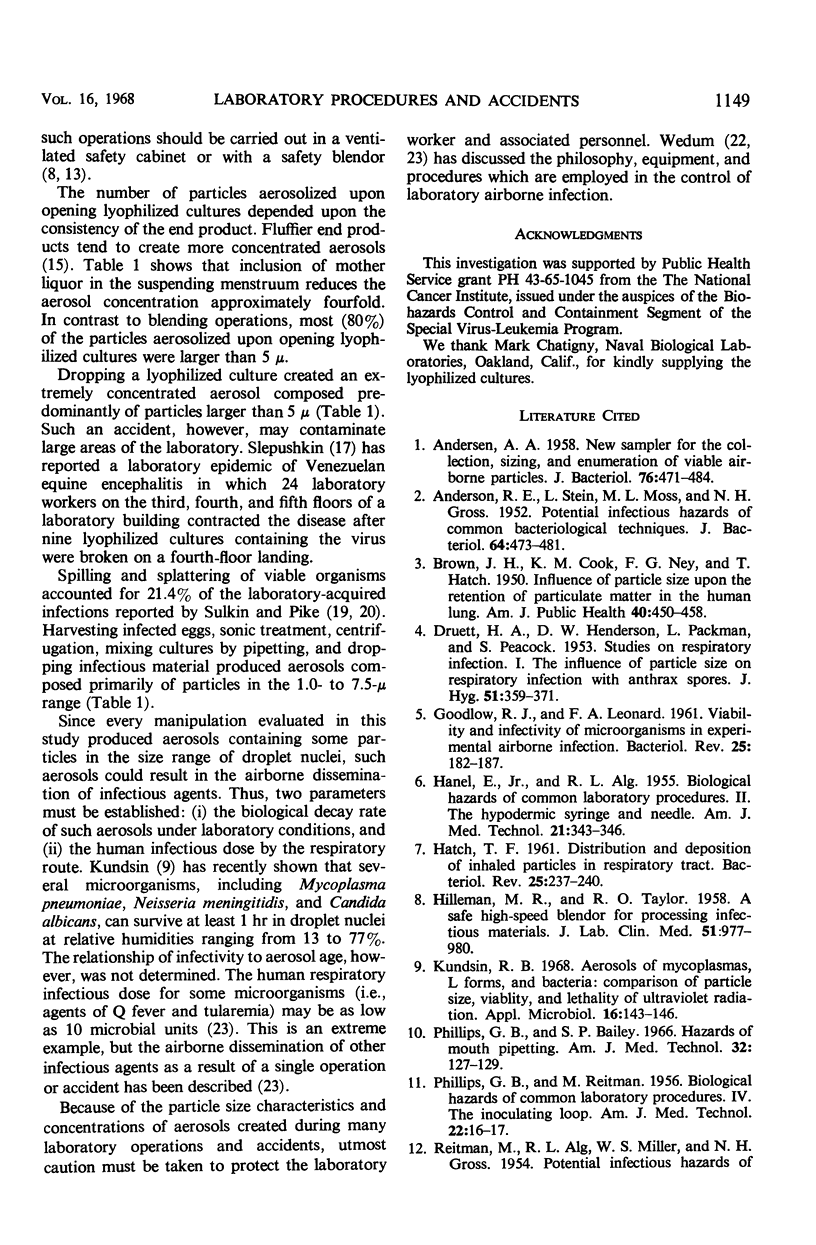Abstract
Andersen air samplers were used to determine the particle size distribution of Serratia marcescens aerosols created during several common laboratory procedures and simulated laboratory accidents. Over 1,600 viable particles per cubic foot of air sampled were aerosolized during blending operations. More than 98% of these particles were less than 5 μ in size. In contrast, 80% of the viable particles aerosolized by handling lyophilized cultures were larger than 5 μ. Harvesting infected eggs, sonic treatment, centrifugation, mixing cultures, and dropping infectious material produced aerosols composed primarily of particles in the 1.0- to 7.5-μ size range.
Full text
PDF




Images in this article
Selected References
These references are in PubMed. This may not be the complete list of references from this article.
- ANDERSEN A. A. New sampler for the collection, sizing, and enumeration of viable airborne particles. J Bacteriol. 1958 Nov;76(5):471–484. doi: 10.1128/jb.76.5.471-484.1958. [DOI] [PMC free article] [PubMed] [Google Scholar]
- ANDERSON R. E., STEIN L., MOSS M. L., GROSS N. H. Potential infectious hazards of common bacteriological techniques. J Bacteriol. 1952 Oct;64(4):473–481. doi: 10.1128/jb.64.4.473-481.1952. [DOI] [PMC free article] [PubMed] [Google Scholar]
- Brown J. H., Cook K. M., Ney F. G., Hatch T. Influence of Particle Size upon the Retention of Particulate Matter in the Human Lung. Am J Public Health Nations Health. 1950 Apr;40(4):450–480. doi: 10.2105/ajph.40.4.450. [DOI] [PMC free article] [PubMed] [Google Scholar]
- DRUETT H. A., HENDERSON D. W., PACKMAN L., PEACOCK S. Studies on respiratory infection. I. The influence of particle size on respiratory infection with anthrax spores. J Hyg (Lond) 1953 Sep;51(3):359–371. doi: 10.1017/s0022172400015795. [DOI] [PMC free article] [PubMed] [Google Scholar]
- GOODLOW R. J., LEONARD F. A. Viability and infectivity of microorganisms in experimental airborne infection. Bacteriol Rev. 1961 Sep;25:182–187. doi: 10.1128/br.25.3.182-187.1961. [DOI] [PMC free article] [PubMed] [Google Scholar]
- HANEL E., Jr, ALG R. L. Biological hazards of common laboratory procedures. II. The hypodermic syringe and needle. Am J Med Technol. 1955 Nov-Dec;21(6):343–346. [PubMed] [Google Scholar]
- HATCH T. F. Distribution and deposition of inhaled particles in respiratory tract. Bacteriol Rev. 1961 Sep;25:237–240. doi: 10.1128/br.25.3.237-240.1961. [DOI] [PMC free article] [PubMed] [Google Scholar]
- HILLEMAN M. R., TAYLOR R. O. A safe high-speed blendor for processing infectious materials. J Lab Clin Med. 1958 Jun;51(6):977–980. [PubMed] [Google Scholar]
- Kundsin R. B. Aerosols of mycoplasmas, L forms, and bacteria: comparison of particle size, viability, and lethality of ultraviolet radiation. Appl Microbiol. 1968 Jan;16(1):143–146. doi: 10.1128/am.16.1.143-146.1968. [DOI] [PMC free article] [PubMed] [Google Scholar]
- PHILLIPS G. B., REITMAN M. Biological hazards of common laboratory procedures. IV. The inoculating loop. Am J Med Technol. 1956 Jan-Feb;22(1):16–17. [PubMed] [Google Scholar]
- Phillips G. B., Bailey S. P. Hazards of mouth pipetting. Am J Med Technol. 1966 Mar-Apr;32(2):127–129. [PubMed] [Google Scholar]
- REITMAN M., FRANK M. A., ALG R., WEDUM A. G. Infectious hazards of the high speed blendor and their elimination by a new design. Appl Microbiol. 1953 Jan;1(1):14–17. doi: 10.1128/am.1.1.14-17.1953. [DOI] [PMC free article] [PubMed] [Google Scholar]
- REITMAN M., MOSS M. L., HARSTAD J. B., ALG R. L., GROSS N. H. Potential infectious hazards of laboratory techniques. I. Lyophilization. J Bacteriol. 1954 Nov;68(5):541–544. doi: 10.1128/jb.68.5.541-544.1954. [DOI] [PMC free article] [PubMed] [Google Scholar]
- REITMAN M., MOSS M. L., HARSTAD J. B., ALG R. L., GROSS N. H. Potential infectious hazards of laboratory techniques. II. The handling of lyophilized cultures. J Bacteriol. 1954 Nov;68(5):545–548. doi: 10.1128/jb.68.5.545-548.1954. [DOI] [PMC free article] [PubMed] [Google Scholar]
- REITMAN M., PHILLIPS G. B. Biological hazards of common laboratory procedures. I. The pipette. Am J Med Technol. 1955 Nov-Dec;21(6):336–342. [PubMed] [Google Scholar]
- STEIN C. D., ROGERSH Recovery of viable microorganism and viruses from vapors removed from frozen suspensions of biologic material during lyophilization. Am J Vet Res. 1950 Jul;11(40):339–344. [PubMed] [Google Scholar]
- SULKIN S. E., PIKE R. M. Survey of laboratory-acquired infections. Am J Public Health Nations Health. 1951 Jul;41(7):769–781. doi: 10.2105/ajph.41.7.769. [DOI] [PMC free article] [PubMed] [Google Scholar]
- TOMLINSON A. J. Infected air-borne particles liberated on opening screw-capped bottles. Br Med J. 1957 Jul 6;2(5035):15–17. doi: 10.1136/bmj.2.5035.15. [DOI] [PMC free article] [PubMed] [Google Scholar]
- WEDUM A. G. Control of laboratory airborne infection. Bacteriol Rev. 1961 Sep;25:210–216. doi: 10.1128/br.25.3.210-216.1961. [DOI] [PMC free article] [PubMed] [Google Scholar]
- WEDUM A. G. LABORATORY SAFETY IN RESEARCH WITH INFECTIOUS AEROSOLS. Public Health Rep. 1964 Jul;79:619–633. [PMC free article] [PubMed] [Google Scholar]
- WHITWELL F., TAYLOR P. J., OLIVER A. J. Hazards to laboratory staff in centrifuging screw-capped containers. J Clin Pathol. 1957 Feb;10(1):88–91. doi: 10.1136/jcp.10.1.88. [DOI] [PMC free article] [PubMed] [Google Scholar]



